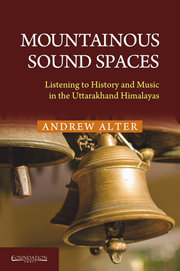Book contents
- Frontmatter
- Contents
- List of Figures
- List of Tables and Musical Examples
- Preface
- Acknowledgements
- Introduction
- 1 Echoes of Colonialism: Bagpipes in the Himalayas
- 2 Echoes of a Royal Heritage: Vestiges of Naubat
- 3 Possession and Performance: Sounding Out the Epic Worlds of Heroes and Gods
- 4 Worlds of Sound: Revisiting the Parameters of Oral Tradition
- 5 Flutes, Sprites and Mountainous Geographies
- 6 Drum Strokes, Syllables and Rhythmic Patterns
- 7 The Significance of Tantric Sects for Drum Practice in the Central Himalayas
- 8 Playing History: Sounding Out the Epic Worlds of Heroes and Gods
- 9 The Legacy of Garhwali Cassettes: Remembering the Pre-digital Age of Music Commodification
- Epilogue: Listening to an Uttarakhandi Himalayan Space
- Bibliography
- Index
8 - Playing History: Sounding Out the Epic Worlds of Heroes and Gods
Published online by Cambridge University Press: 05 October 2014
- Frontmatter
- Contents
- List of Figures
- List of Tables and Musical Examples
- Preface
- Acknowledgements
- Introduction
- 1 Echoes of Colonialism: Bagpipes in the Himalayas
- 2 Echoes of a Royal Heritage: Vestiges of Naubat
- 3 Possession and Performance: Sounding Out the Epic Worlds of Heroes and Gods
- 4 Worlds of Sound: Revisiting the Parameters of Oral Tradition
- 5 Flutes, Sprites and Mountainous Geographies
- 6 Drum Strokes, Syllables and Rhythmic Patterns
- 7 The Significance of Tantric Sects for Drum Practice in the Central Himalayas
- 8 Playing History: Sounding Out the Epic Worlds of Heroes and Gods
- 9 The Legacy of Garhwali Cassettes: Remembering the Pre-digital Age of Music Commodification
- Epilogue: Listening to an Uttarakhandi Himalayan Space
- Bibliography
- Index
Summary
Connections between drum notation, drum syllables and the power of oralized sound are audible/viewable in numerous rituals throughout Uttarakhand. Whether such rituals involve a procession with a specific temple deity, or whether they are part of more general ritual activity associated with festivals (melās) or outdoor jāgaraṇ, references to Śaiva-Śākta theologies and practices are frequently present. The small town of Purnath (pseudonym), which is located in central Garhwal, holds an annual melā (festival) that provides just such an example. Events associated with the deity's original acquisition are re-enacted by townspeople as both a form of worship and as a dramatic spectacle. In this way, the melā provides an opportunity for participants to simultaneously worship their deity and reaffirm their interlinked identities. This chapter examines the melā by documenting and analyzing the unique musical repertoire used to accompany what is essentially a sacred performance. The deity's connection to Shiva as well as the town's association with Nath practitioners makes the Purnāth Melā a particularly apt space within which to examine connections between ritual practice and drum repertoire.
Knowledge of the musical repertoire that accompanies the ritual aspects of the Purnāth Melā is maintained by specialist drummers who live in the town. Their explanation of how music is related to historical re-enactment provides the framework for the description presented here. Metaphysical explanations of music's central place in the existence/creation of the world clarify the role of sound in ritual action and provide the basis for how sacred and historical realms may become merged.
- Type
- Chapter
- Information
- Mountainous Sound SpacesListening to History and Music in the Uttarakhand Himalayas, pp. 109 - 126Publisher: Foundation BooksPrint publication year: 2014

